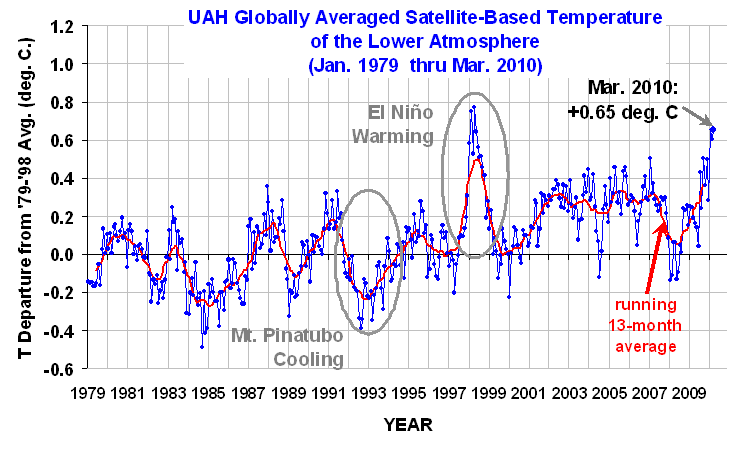YR MON GLOBE NH SH TROPICS
2009 1 0.252 0.472 0.031 -0.065
2009 2 0.247 0.569 -0.074 -0.044
2009 3 0.191 0.326 0.056 -0.158
2009 4 0.162 0.310 0.013 0.012
2009 5 0.140 0.160 0.120 -0.057
2009 6 0.044 -0.011 0.100 0.112
2009 7 0.429 0.194 0.665 0.507
2009 8 0.242 0.229 0.254 0.407
2009 9 0.504 0.590 0.417 0.592
2009 10 0.361 0.335 0.387 0.381
2009 11 0.479 0.458 0.536 0.478
2009 12 0.283 0.350 0.215 0.500
2010 1 0.649 0.861 0.437 0.684
2010 2 0.603 0.725 0.482 0.792
2010 3 0.653 0.853 0.454 0.726
The global-average lower tropospheric temperature continues to be quite warm: +0.65 deg. C for March, 2010. This is about the same as January. Global average sea surface temperatures (not shown) remain high.
As a reminder, last month we change to Version 5.3 of our dataset, which accounts for the mismatch between the average seasonal cycle produced by the older MSU and the newer AMSU instruments. This affects the value of the individual monthly departures, but does not affect the year to year variations, and thus the overall trend remains the same as in Version 5.2.
ALSO…we have now added the NOAA-18 AMSU, which provides data since June of 2005. The local observation time of NOAA-18 (now close to 2 p.m., ascending node) is similar to that of NASA’s Aqua satellite (about 1:30 p.m.). The temperature anomalies listed above have changed somewhat as a result of adding NOAA-18.
[NOTE: These satellite measurements are not calibrated to surface thermometer data in any way, but instead use on-board redundant precision platinum resistance thermometers (PRTs) carried on the satellite radiometers. The PRT’s are individually calibrated in a laboratory before being installed in the instruments.]

 Home/Blog
Home/Blog




